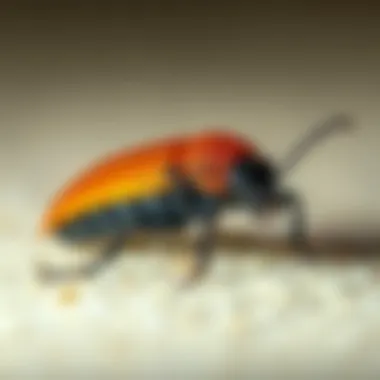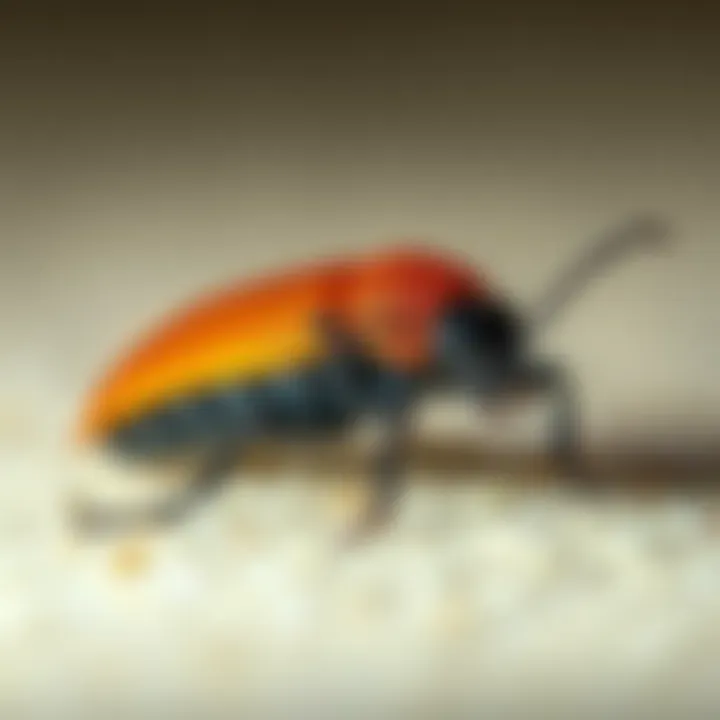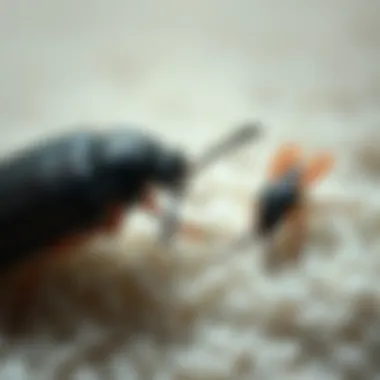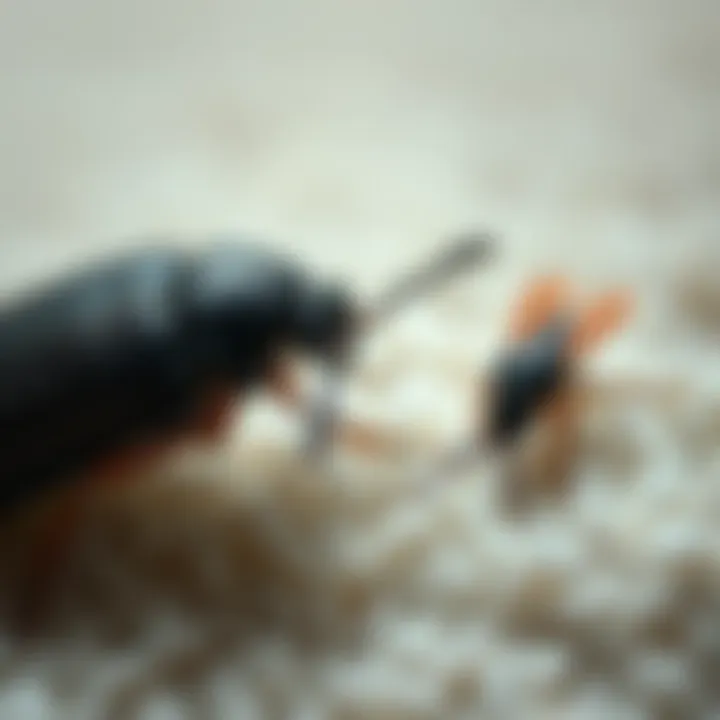Effective Strategies to Prevent Carpet Beetle Infestations


Intro
In every home, there exists a hidden threat that can wreak havoc on cherished belongings, particularly those crafted from fabric. Carpet beetles may be small, but their impact can be monumental when left unchecked. Understanding these pests is the first step in ensuring your home remains untarnished by their destructive appetite. This article goes beyond mere identification. It is crafted to arm homeowners, particularly housewives and house owners, with comprehensive strategies that not only prevent carpet beetles from invading but also foster a deeper understanding of pest behavior and management.
As we dive into this structured guide, we will explore the biology of carpet beetles, essential prevention techniques, and eco-friendly control solutions. Every detail will illuminate the path to a pest-free environment, ensuring you can enjoy your home without fear of fabric damage. Let’s unravel the threads of this topic, starting with an in-depth look into the pests themselves.
Understanding Carpet Beetles
Understanding carpet beetles is fundamental for homeowners, especially those who take pride in their fabrics and belongings. These tiny creatures, while often overlooked, can wreak havoc if given the chance to invade your space. This section sheds light on the biology, common species, and behavioral patterns of these pests, enabling homeowners to recognize their risks and adopt preventive measures effectively.
Biology and Life Cycle
Carpet beetles belong to the family Dermestidae, which includes various species known for their destructive habits. Typically, there are three main types found in homes: the black carpet beetle, the varied carpet beetle, and the furniture carpet beetle. Each has distinct characteristics, but they share common biological traits.
The life cycle of carpet beetles consists of four stages: egg, larva, pupa, and adult. The journey begins when a female beetle lays approximately 40 to 100 eggs in places like carpets, upholstery, or other fabric materials. These eggs hatch into larvae within a week or two, seeking organic materials such as wool, fur, and feathers for sustenance. This larval stage can last from several months to over a year, depending on environmental conditions. Once mature, they transform into pupae, eventually emerging as adult beetles ready to continue the cycle.
This knowledge of their life cycle is crucial for understanding when and where infestations may occur, allowing for timely interventions. Regular inspections within your home, particularly in fabric-heavy areas, can help spot early signs of these pests before they become a larger issue.
Common Species
Understanding the differences between common species of carpet beetles will assist in identifying precisely what you are up against.
- Black Carpet Beetle: Recognizable by its dark, oval body, this beetle can grow up to 5 mm long. It's known for causing significant damage to natural fibers.
- Varied Carpet Beetle: Slightly smaller, it displays a diverse color pattern, often with a mix of whites and browns. Like its black counterpart, it prefers wool and similar materials but also feeds on plant products.
- Furniture Carpet Beetle: These are typically about 5 mm long, identified by their distinct segments covered with fine hair that can vary in color.
Each species varies slightly in behavior and preferred environment, but they all thrive on organic fibers. Thus, an awareness of which species are likely to invade your home is an effective first step in damage prevention.
Behavioral Patterns
Carpet beetles are not nocturnal, so they are more active in dim lighting conditions. This means they can often go unnoticed until significant damage has occurred. Adults tend to feed on pollen and nectar but can still find their way into homes, especially if doors or windows are left open during flowering seasons.
The larvae are particularly skilled at hiding, making detection difficult. They are not just nuisances; their presence can suggest a wider issue with cleanliness or storage practices in the home. It's noteworthy that these pests may also have a longer growth period in warmer climates, leading to more severe infestations.
"Prevention is better than cure. Knowing where these insects thrive is a valuable insight in pest control."
Identifying Carpet Beetle Infestations
Identifying carpet beetle infestations is a crucial step in safeguarding your home from these persistent pests. Knowing the signs of their presence can save homeowners a lot of heartache and even more financial damage. Carpet beetles tend to go unnoticed until the destruction they cause is significant. By understanding what to look for, you’ll be able to intervene before they wreak havoc on your carpets, clothes, and upholstery.
Visual Signs of Infestation
Carpet beetles are sneaky little critters, often blending into their surroundings. The first indication of their presence might be strange holes appearing in fabrics or even shed skins lying around. Keep your eyes peeled for signs such as:
- Tiny holes in wool, silk, and cotton textiles
- Larvae that resemble small caterpillars with bristly bodies, often yellow or dark brown
- Adult beetles, which can sometimes be mistaken for ladybugs due to their size and shape, usually about 1/8 to 1/4 inch long and can be black, brown, or patterned
- Fecal pellets, which are small, dark specks, often found near their food sources
These visual markers can alert you to a potential infestation, enabling you to act before too much damage is done.
Detecting Larvae and Adult Beetles
To effectively tackle carpet beetle issues, it’s necessary to understand how to spot both larvae and adults. The larvae tend to hide in dark and secluded spaces, often making their nests in closets, beneath beds, or in dark corners of a room.
Here are some practical tips to find them:
- Check under furniture and along baseboards where dust gathers.
- Inspect closets, especially those with stored clothes or linens, as these are prime targets for larvae.
- Don’t forget to look in light fixtures, as adult beetles are often attracted to light and can get trapped
Conducting regular inspections will help you catch any signs before they escalate.


Understanding Damage Patterns
Carpet beetles are rather methodical in their destruction. The damage they cause is not random; it tends to follow particular patterns. Here are some key points:
- Preferential Eating: They tend to prefer natural fibers like wool, silk, or cotton. If you notice damage on these materials, it’s a red flag.
- Concentrated Areas of Damage: Often, the damage remains localized in certain areas, such as overlapping seams, folds, or hidden spots where larvae can munch away without being seen.
- Damage Over Time: Unlike other pests, the damage from carpet beetles accumulates over time, often starting small and then expanding significantly as populations grow.
Being alert to these patterns can empower you to take preemptive actions.
"The earlier you spot them, the easier it is to stop their destructive trail."
Preventive Measures
Preventive measures are key when dealing with carpet beetles. These tiny pests can quietly wreak havoc in your home if proper steps are not taken to control them. By adopting effective strategies, homeowners can limit their risk of infestation, thus protecting their treasured fabrics and belongings. The benefits of preventive measures include maintaining a clean environment, prolonging the life of textiles, and saving money that might otherwise go towards costly pest control services. Adapting your daily habits and routines to include specific practices can create a less inviting atmosphere for these beetles.
Regular Cleaning Routines
Vacuuming Techniques
A good vacuum cleaner can become your best friend in battle against carpet beetles. Regular vacuuming not only removes debris and dust but also extracts the larvae and adults hiding in your carpets and upholstery. Ensure your vacuum has strong suction and the appropriate attachments to reach into those nooks and crannies where beetles love to hide. The most effective technique is to use slow, deliberate strokes with your vacuum cleaner, making several passes over each area to capture even the most stubborn pests. One unique aspect is that using a vacuum with a HEPA filter can help contain allergens and prevent reintroducing pests.
However, keep in mind that while vacuuming is beneficial, it needs to be done frequently to be truly effective.
Cleaning Fabrics and Textiles
Cleaning fabrics and textiles is equally important. Regular laundering of items such as linens, curtains, and clothing can eliminate potential hiding spots for beetles. High temperatures, especially during washing and drying, help ensure that any eggs or larvae are killed off. The key characteristic of this method is that it targets not just existing adults but also any developing larvae.
One thing to consider is how fabric types react to cleaning methods; delicate materials may require special care to avoid damage.
Storage and Organization Strategies
Using Airtight Containers
Using airtight containers is a surefire way of protecting seasonal clothing and textiles from carpet beetles. When you place items in sealed containers, you create a formidable barrier against pests looking to make a meal out of your belongings. It's imperative that these containers are sturdy and completely sealed, leaving no gaps for insects to sneak through. This method has the advantage of being simple and effective; it prevents infestations before they have a chance to develop.
However, the downside can be the initial investment in quality containers and the need to properly sort and store items.
Seasonal Clothing Management
Seasonal clothing management involves regularly rotating your wardrobe and ensuring that out-of-season items are cleaned and stored properly. During this process, inspect garments for signs of larvae or damage. Items like winter coats or summer dresses should be thoroughly checked to make sure no pests are hibernating. The benefit of this approach is that it keeps your clothing in top shape while also ensuring that you minimize the chances of an infestation getting out of hand.
The unique feature here is the proactive stance that seasonal management encourages. Staying ahead of potential issues can both safeguard your belongings and simplify future storage efforts.
Monitoring and Maintenance
Regular Inspections
Regular inspections are essential in identifying potential pest problems before they become a full-fledged infestation. By routinely checking areas prone to beetle activity, such as closets, storage rooms, and behind appliances, you can catch an infestation early on. The key characteristic of this tactic is its preemptive nature; you're tackling issues head-on before they spiral out of control.
This method might require a bit of time and effort to develop into a habit, but the long-term benefits are worth it.
Utilizing Traps and Monitoring Devices
Utilizing traps and monitoring devices can significantly enhance your preventive strategy. Placing sticky traps in high-risk areas can help gauge if carpet beetles could be nearby. These devices not only catch pests but also alert you to the presence of beetles, giving you valuable time to act. A unique feature of these devices is that they work silently in the background, requiring little maintenance while you monitor their effectiveness.
The primary drawback is that while they can inform you of a problem, they require further action, such as cleaning or pest management, to actually resolve the issue.


Chemical and Non-Chemical Control Methods
When dealing with the persistent threat of carpet beetles, understanding both chemical and non-chemical control methods proves essential. This dual approach allows homeowners to effectively combat infestations while also considering safety and environmental impact. By integrating efficient pest control practices, one can maintain not only the integrity of valuable textiles and furnishings but also their peace of mind.
Insecticides and Pesticides
Types of Insecticides
Insecticides serve as a strong line of defense against carpet beetles. One of the key characteristics of these products is their ability to eliminate pests quickly. Among several types, pyrethrins and pyrethroids are often favored. Pyrethrins, derived from chrysanthemum flowers, present an organic option that targets the nervous systems of beetles, leading to rapid eradication. Meanwhile, synthetic pyrethroids provide even longer-lasting efficacy against various insect species.
Choosing insecticides containing these compounds can be advantageous, as they are typically effective against both larvae and adult beetles. However, it’s important to be aware of potential drawbacks—overuse may lead to resistance in pests, making future control efforts less effective. Select insecticides that specifically mention carpet beetles on their labels to ensure relevance and effectiveness.
Safety Precautions
In conjunction with the use of insecticides, safety precautions cannot be overlooked. When applying any pesticide, it’s vital to adhere to the manufacturer's instructions; this includes dosage and application frequency. Make sure to wear protective gear, such as gloves and masks, particularly when spraying in confined areas. The unique feature of safety precautions lies in their dual role: not only do they protect you and your family from potential chemical exposure, but they also help to maximize the effectiveness of the treatment.
Be mindful of your surroundings during application, ensuring that children and pets are kept at a safe distance. Moreover, ensure that your home is well-ventilated after treatment. This attention to safety can aid in reducing health risks while maintaining optimal pest control.
Natural Remedies
Natural remedies offer a more holistic approach for those wary of chemical solutions. Incorporating environmentally friendly treatments can effectively deter carpet beetles without the adverse effects that some chemicals may cause.
Essential Oils
One standout option among natural remedies is essential oils. Certain oils, like lavender, eucalyptus, and peppermint, have proven to repel carpet beetles due to their strong scents. Not only do they emit a pleasant aroma, they also serve as an effective deterrent against these pests. An appealing aspect of essential oils is their ease of use; they can be diluted in water and sprayed onto affected areas or added to cleaning solutions.
While essential oils are generally safe for use in homes, their effectiveness can vary. They may not kill pests outright, but they can significantly reduce their presence. Hence, combining their use with other preventive measures boosts overall effectiveness.
Homemade Sprays
Creating homemade sprays offers an alternative that is both cost-effective and straightforward. Common household items, like vinegar and soap, can be combined into a solution that disrupts the beetles' ability to thrive. For instance, mixing equal parts vinegar and water in a spray bottle can act as a natural repellent when sprayed on carpets and fabrics.
A major advantage of homemade sprays is their lack of harsh chemicals, making them a safer choice for family households. However, their effectiveness may wane compared to commercially available insecticides. Regular reapplication might be necessary to maintain a pest-free environment.
A proactive stance involving both chemical and natural control methods not only combats present carpet beetle populations but also aids in preventing future infestations.
In summary, exploring various control methods—whether chemical or natural—enables homeowners to tailor their approach to pest management effectively. By considering their specific situation and preferences, one can create a multi-faceted strategy that ensures lasting protection against carpet beetles.
The Role of Professional Pest Control
When it comes to dealing with carpet beetles, the importance of professional pest control cannot be emphasized enough. These tiny pests can wreak havoc in your home, causing damage to fabrics, upholstery, and various other materials. A professional pest control service specializes in identifying the extent of the infestation and deploying effective strategies to not only eliminate the problem but prevent it from reoccurring.
By engaging professional assistance, homeowners can tap into a wealth of knowledge and experience. Pest control experts are trained to recognize different species of carpet beetles and understand their life cycles, which informs the most effective methods for eradication. This understanding is crucial, as treating a beetle infestation improperly can lead to the persistence of the problem, making it even harder to manage in the future.
"A stitch in time saves nine"—this old adage is particularly true when it comes to pest control. Addressing issues sooner rather than later can save homeowners from extensive damages.
When to Seek Professional Help
Understanding when to call in the pros is a critical aspect of managing a carpet beetle problem. Homeowners should not hesitate to reach out for help if they notice signs of an infestation, such as larvae in corners or damage to fabrics. If vacuuming and cleaning routines fail to control the situation, it may be time to consider professional intervention.
Certain situations also warrant immediate professional attention. For example, if one finds multiple clusters of beetles, potentially indicating a larger breeding ground, or if restoration of valuable materials is at stake, acting fast and getting a professional involved is essential. Remember, the faster you act, the less damage you’ll likely endure.
Choosing a Pest Control Service
Finding the right pest control service can feel overwhelming, but some key considerations can streamline the process.


Researching Options
Researching options is fundamental when choosing a pest control service. Homeowners should look for providers with strong local reputations and favorable reviews. Engaging with online forums or community boards—like those on Facebook or Reddit—can also yield insights. Key characteristics to look out for include:
- Experience with carpet beetle infestations specifically
- The qualifications and training of their technicians
- Customer testimonials about effectiveness and reliability
While the plethora of choices might feel daunting, it’s important to recognize that thorough research can help you find a service that well suits your need. Engaging with several companies, asking questions, and comparing services often lead to selecting an effective pest control partner.
Evaluating Effectiveness
Once you have a shortlist of potential pest control services, evaluating their effectiveness is critical. Homeowners should ask for references and data on past successes against carpet beetles. Key characteristics to consider in this evaluation include:
- The methods and tools they use for treatment
- Guarantees on service and follow-up treatments
- Key performance indicators such as speed of service and customer service responsiveness
Evaluating effectiveness also comes down to transparency in communication. A company that clearly lays out its treatment plan and is open about the products used taken the stress out of an already overwhelming situation, making it a top choice for homeowners looking for trusted pest control solutions.
Long-Term Strategies for Pest Management
In the pursuit of an effective solution for tackling carpet beetles, it’s essential to understand long-term strategies for pest management. A comprehensive approach not only targets the current array of pests but also aims to prevent future invasions, ensuring your home remains a sanctuary. These strategies involve combining multiple practices to create an environment that is less hospitable to these undesirable guests.
Integrated Pest Management Practices
Integrated Pest Management, or IPM, stands out as a modern approach to pest control. The beauty of IPM is that it employs a blend of techniques and practices that work together harmoniously. This includes, but isn't limited to, biological control, habitat manipulation, cultural practices, and the judicious use of pesticides.
One of the cornerstones of this method is monitoring. By observing your home regularly for signs of pests, you can catch an infestation before it spirals out of control. Then, there’s the practical side of things: you can enhance your cleaning routines and aim for preventive measures. For instance, keeping your spaces well-ventilated and decluttering helps deter carpet beetles, as they prefer dark, confined spaces. The key characteristic of this approach lies in its adaptability, making it a popular selection among homeowners eager to foster an ongoing, sustainable solution without resorting to heavy chemical usage.
Creating an Insect-Proof Environment
Creating an insect-proof environment forms the bedrock of long-term pest control. This involves a combination of physical barriers and environmental adjustments that work together to restrict pest access and breeding opportunities.
Sealing Entry Points
Sealing entry points is a proactive step that pays dividends in the long run. By ensuring that gaps around windows, doors, and cracks in walls are adequately sealed, you significantly reduce the chances of carpet beetles and other pests entering your home. This process often involves using caulk or weather stripping to fill small openings while employing mesh screens for larger areas.
The key characteristic of sealing entry points is its preventive nature. Homeowners who make this effort can sleep soundly knowing they are proactively shielding their space. A unique advantage of this method is its straightforward implementation; even those who aren’t particularly handy can undertake these tasks with minimal fuss. However, it requires consistent upkeep as wear and tear can open previously sealed gaps over time.
Landscaping for Pest Prevention
Landscaping for pest prevention complements sealing entry points beautifully. Proper landscaping not only beautifies your yard but also acts as a strategic barrier against pests. Certain plants can deter unwanted insects, while placement of garden beds and mulch can cut down on the areas where pests breed.
Noteworthy in this practice is the selection of plants. For instance, incorporating aromatic herbs like lavender or rosemary can deter carpet beetles and other common pests. The unique feature of landscaping as pest prevention is its dual benefit: it enhances your outdoor aesthetics while working tirelessly to protect your home indoors.
While this method boasts advantages like improved curb appeal and pest avoidance, it's crucial to consider potential drawbacks. For example, depending on the local climate, some plants may require more maintenance than others. Nevertheless, through mindful selection and care, homeowners can enjoy the benefits of a beautiful landscape designed to thwart pests effectively.
Ending
In wrapping up our discussion on carpet beetles, it becomes clear that addressing these uninvited guests effectively hinges on a multifaceted approach. The significance of understanding not just the immediate actions we can take, but also the long-term strategies cannot be understated. Prevention is the name of the game. By incorporating diligent cleaning routines, strategic organization of belongings, and keeping abreast of any signs of infestation, homeowners can cultivate an environment that deters these pests before they wreak havoc.
Summarizing Key Points
Throughout this article, several crucial elements have emerged:
- Biology: Understanding the life cycle and habits of carpet beetles lays the foundation for effective prevention.
- Identification: Recognizing the signs of infestations, whether through visual sign or the remnants of larvae, is vital. Ignorance can lead to costly damages.
- Preventive Measures: Regular cleaning, effective storage solutions, and maintaining the integrity of one's home serve as the first line of defense.
- Control Methods: Knowing when to implement chemical or natural solutions can save time and limit damage.
- Professional Help: Under certain circumstances, expert intervention may be necessary to address larger infestations or implement more rigorous pest control plans.
Each of these points contributes to a holistic approach to preventing carpet beetle infestations.
Encouraging Proactive Measures
Taking proactive measures is essential for any homeowner. Rather than waiting for a problem to escalate, consider integrating some of these habits into your routine:
- Routine Inspections: Regularly check areas where carpet beetles may hide, such as closets, under furniture, and in storage containers. Catching an issue early can save you from greater troubles down the line.
- Implementing Traps: Setting traps in high-risk areas can help monitor any potential infestations. This gesture can be a wise investment in avoiding larger problems.
- Educate Yourself: Familiarize yourself with the behavior of these pests. Knowledge is power, and understanding what attracts them can help you make informed decisions.
- Share Knowledge: Talk to neighbors and family about prevention. Sometimes, sharing insights within your community can foster a collective effort to keep pests at bay.
- Commit to Cleanliness: A clutter-free space not only prevents carpet beetles but also enhances the overall ambiance of your home.
Taking these proactive steps can empower homeowners, ensuring that they not only enjoy a pest-free environment but also conserve their cherished fabrics and possessions from unwanted damage.



